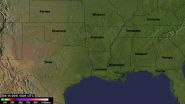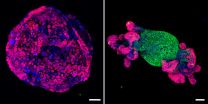NASA provides many views of Tropical Depression Bill
2015-06-18
(Press-News.org) NASA provided four different views of Tropical Depression Bill as it continued traveling through the south-central U.S. and into the Ohio Valley. NASA's Aqua and Terra satellite provided infrared and visible imagery while NASA/NOAA's GOES Project animated NOAA's GOES-East satellite imagery to show the storm's progression since landfall. The Global Precipitation Measurement or GPM core satellite also showed rainfall estimates and locations.
On June 18, the National Weather Service, Weather Prediction Center (NWS/WPC) noted that flood and flash flood watches and warnings are in effect for eastern Texas and Oklahoma and into the middle Mississippi River Valley and portions of the western Ohio Valley.
An animation of GOES-East satellite imagery from June 16 to 18 was created at NASA/NOAA's GOES Project at the NASA Goddard Space Flight Center in Greenbelt, Maryland. The animation showed the Tropical Depression Bill moving over Texas, Oklahoma and moving into the Ohio Valley.
On June 17, the MODIS instrument aboard NASA's Terra satellite captured an image of Tropical Depression Bill over northeastern Texas. In the image, a band of moisture from the Gulf of Mexico was being swept up into the eastern quadrant of the storm, while another band of thunderstorms stretched northeast of the center. The MODIS data was made into an image at NASA Goddard.
On June 18 at 08:41 UTC (4:41 a.m. EDT) infrared data from the AIRS instrument aboard NASA's Aqua satellite was made into a false-colored infrared image to show temperature. AIRS data can identify the coldest, highest cloud tops with potential heavy rainfall. The data showed cold cloud tops and thunderstorms over most of Oklahoma (except the panhandle), stretching into southeastern Kansas. The AIRS data was made into an image at NASA's Jet Propulsion Laboratory in Pasadena, California.
Data from the NASA's Integrated Multi-satellitE Retrievals for GPM (IMERG) was used in an analysis to estimate rainfall from Tropical Depression Bill. Precipitation was analyzed from the time when Tropical Depression Bill was forming in the Gulf Of Mexico on Monday June 15, 2015 until June 18, 2015 at 0600 UTC (2 a.m. EDT). The data showed rainfall from Tropical Depression Bill was spreading over Oklahoma while rainfall from a frontal system was also occurring in the northern states. The GPM observatory is co-managed by both NASA and the Japanese Space Agency.
The NWS expects Tropical Depression Bill to produce total rain accumulations of 4 to 8 inches across eastern Oklahoma, northwest Arkansas and into southern Missouri. Locally higher amounts up to 12 inches may also be possible. Additional amounts of 1 to 2 inches possible into portions of southeastern Texas. Rainfall amounts of 2 to 4 inches are possible farther northeast into the Ohio River Valley. These rains may produce life-threatening flash floods.
At 5 a.m. EDT (0900 UTC) on June 18, the center of Bill was located near Latitude 34.5 North and longitude 96.4 West. That places Bill's center of circulation about 80 miles (129 km) southeast of Oklahoma City, Oklahoma. Maximum sustained winds were near 25 mph (40 kph). Bill was moving to the north-northeast at 10 mph (16 kph). Tropical depression Bill continues to move north-northeastward into southern Oklahoma.
NWS/WPC noted that Bill is forecast to move across southeastern Oklahoma on Thursday, June 18 and southern Missouri by Friday, June 19. Bill is expected to gradually weaken over the next few days. For updates, visit: http://www.wpc.ncep.noaa.gov/tropical/tropstorms.shtml
INFORMATION:
NWS SELECTED STORM TOTAL RAINFALL IN INCHES THROUGH 5 AM EDT ON JUNE 18
ARKANSAS
HARRISON/BOONE CO. ARPT 1.48
BENTONVILLE 1.43
OKLAHOMA
NEWPORT 13.07
BURNEYVILLE 10.09
RINGLING 8.27
SULPHUR 7.09
TEXAS
MONTAGUE 12.50
GANADO 1.5 W 11.77
ALICE INTL ARPT 9.03
WF SAN JACINTO 7.06
CORPUS CHRISTI 6.14
WACO 0.8 N 3.91
AUSTIN 5 E 3.72
SAN ANTONIO INTL ARPT 2.43
HOUSTON 2.09
GALVESTON/SCHOLES 1.42
ELSE PRESS RELEASES FROM THIS DATE:
2015-06-18
Kangaroos prefer to use one of their hands over the other for everyday tasks in much the same way that humans do, with one notable difference: generally speaking, kangaroos are lefties. The finding, reported in the Cell Press journal Current Biology on June 18--the first to consider handedness in wild kangaroos--challenges the notion that "true" handedness among mammals is a feature unique to primates.
"According to a special-assessment scale of handedness adopted for primates, kangaroos pulled down the highest grades," says Yegor Malashichev of Saint Petersburg State ...
2015-06-18
Anti-cancer strategies generally involve killing off tumor cells. However, cancer cells may instead be coaxed to turn back into normal tissue simply by reactivating a single gene, according to a study published June 18th in the journal Cell. Researchers found that restoring normal levels of a human colorectal cancer gene in mice stopped tumor growth and re-established normal intestinal function within only 4 days. Remarkably, tumors were eliminated within 2 weeks, and signs of cancer were prevented months later. The findings provide proof of principle that restoring the ...
2015-06-18
American scientists have discovered that a drug commonly used to treat osteoporosis in humans also stimulates the production of cells that control insulin balance in diabetic mice. While other compounds have been shown to have this effect, the drug (Denosumab) is already FDA approved and could more quickly move to clinical trials as a diabetes treatment. The research is published June 18 in Cell Metabolism.
Diabetes is a major health issue worldwide that arises due to a deficiency of insulin-producing beta cells in the pancreas. In type 1 diabetes, beta cells die from ...
2015-06-18
Cutaneous melanoma, the most deadly form of skin cancer, is now believed to be divided into four distinct genomic subtypes, say researchers at The University of Texas MD Anderson Cancer Center, a finding that could prove valuable in the ever-increasing pursuit of personalized medicine.
As part of The Cancer Genome Atlas, researchers identified four melanoma subtypes: BRAF, RAS, NF1 and Triple-WT, which were defined by presence or absence of mutations from analysis of samples obtained from 331 patients. The five-year study resulted from an international collaboration of ...
2015-06-18
PHILADELPHIA -- Most of us need seven to eight hours of sleep a night to function well, but some people seem to need a lot less sleep. The difference is largely due to genetic variability. In research published online June 18th in Current Biology, researchers report that two genes, originally known for their regulation of cell division, are required for normal slumber in fly models of sleep: taranis and Cyclin-dependent kinase 1 (Cdk1).
'There's a lot we don't understand about sleep, especially when it comes to the protein machinery that initiates the process on the ...
2015-06-18
In 2012, researchers at the Stanford University School of Medicine showed that heart muscle cells made from the skin of people with a cardiac condition called dilated cardiomyopathy beat with less force than those made from the skin of healthy people. These cells also responded less readily to the waves of calcium that control the timing and strength of each contraction.
Now, the same research team has teased apart the molecular basis for these differences and identified a drug treatment that at least partially restores function to diseased cells grown in a laboratory ...
2015-06-18
Adult neural stem cells, which are commonly thought of as having the ability to develop into many type of brain cells, are in reality pre-programmed before birth to make very specific types of neurons, at least in mice, according to a study led by UC San Francisco researchers.
"This work fundamentally changes the way we think about stem cells," said principal investigator Arturo Alvarez-Buylla, UCSF professor of neurological surgery, Heather and Melanie Muss Endowed Chair and a principal investigator in the UCSF Brain Tumor Research Center and the Eli and Edythe Broad ...
2015-06-18
We can alter our facial features in ways that make us look more trustworthy, but don't have the same ability to appear more competent, a team of New York University psychology researchers has found.
The study, which appears in the Personality and Social Psychology Bulletin, a SAGE journal, points to both the limits and potential we have in visually representing ourselves--from dating and career-networking sites to social media posts.
"Our findings show that facial cues conveying trustworthiness are malleable while facial cues conveying competence and ability are significantly ...
2015-06-18
Want to lose abdominal fat, get smarter and live longer? New research led by USC's Valter Longo shows that periodically adopting a diet that mimics the effects of fasting may yield a wide range of health benefits.
In a new study, Longo and his colleagues show that cycles of a four-day low-calorie diet that mimics fasting (FMD) cut visceral belly fat and elevated the number of progenitor and stem cells in several organs of old mice -- including the brain, where it boosted neural regeneration and improved learning and memory.
The mouse tests were part of a three-tiered ...
2015-06-18
Last June, in the early days of the Ebola outbreak in Western Africa, a team of researchers sequenced the genome of the deadly virus at unprecedented scale and speed. Their findings revealed a number of critical facts as the outbreak was unfolding, including that the virus was being transmitted only by person-to-person contact and that it was picking up new mutations through its many transmissions.
While public health officials now believe the worst of the epidemic is behind us, it is not yet over, and questions raised by the previous work still await answers.
To ...
LAST 30 PRESS RELEASES:
[Press-News.org] NASA provides many views of Tropical Depression Bill





